Hypocritical Morality
Mumbai’s Ban on Bar Dancers
Flavia Agnes
On July 21, 2005, the Bill to ban the dance bars in Maharashtra was passed unanimously at the end of a ‘marathon debate’. It was a sad day for some of us paltry group of women activists, who had supported the bar dancers and opposed the ban. We were far outnumbered by the pro-ban group, the ‘Dance Bar Virodhi Manch’ who had submitted 150,000 signatures to the Maharashtra state assembly insisting on the closure of dance bars. The ban comes into effect from August 15.
We were sad, not because we were outnumbered, not even because the Bill was passed unanimously, but because of the manner in which an important issue relating to women was discussed, the comments that were passed on the floor of the House, by our elected representatives, who are under the constitutional mandate to protect the dignity of women! Subsequently, we have heard rumours that some of these comments have been withdrawn and will not be reflected in the reported proceedings. But this cannot obviate the fact that this is the way our elected representatives think about women.
One of the comments was aimed at us. ‘These women who are opposing the ban, we will make their mothers dance….’ (The comments have to be translated into Marathi to gauge its impact.) During the campaign we had been asked, ‘Will you send your daughter to dance in a bar?’ But on the floor of the House, the situation had regressed, from our daughters to our mothers! They sniggered: “Isha Koppikar… she is an atom bomb, atom bomb…” This evoked great deal of laughter and cheer… “The dancers wear only 20 per cent clothes”… More laughter and cheering… “These women who dance naked (nanga nach), they don’t deserve any sympathy”. A round of applause.
An esteemed member narrated an incident of his friend’s daughter whohad committed suicide because she did not get a job. He said it was more dignified to commit suicide than dance in bars. And the House applauded! The message for women is clear: If you happen to be born in a poor family, you are better off dead! Yet another congratulated the Deputy Home Minister for taking this bold and revolutionary step, but this was not enough. He urged that “hotels with three stars… five stars, disco dancing …belly dancing … all that is vulgar… every thing should be banned, except Bharatnatyam and Kathak.”
| Legislators opined that – western, English and Tamil films are all obscene. But they did not say a word about Hindi and Marathi films presumably because these belong to “amchi Mumbai”. Then another esteemed membervdeclared, ‘We are not Taliban, but somewhere we have to put a stop. The moral policing we do, it is a good thing, but it is not enough … we need to do even more of this moral policing.’ Suddenly the term ‘moral policing’ had been turned into a hallowed phrase! These comments were not from the ruling party members who had tabled the Bill. They were from the Opposition. Their traditional role is to criticize a bill, to puncture holes in it, to present a counter viewpoint. But on that day, the House was united across party lines and all were playing to the gallery with their moral oneupmanship. Even the Shiv Sena whose party high command is linked to a couple of dance bars in the city, supported the ban. And the Marxists were at one with the Shiv Sainiks. The speech by the CPI(M) member wasmore scathing than the rest. The women members, though a small minority, happily cheered the barrage against bar dancers. The ‘morality’ issue had won. The ‘livelihood’ issue had lost. How the state will |
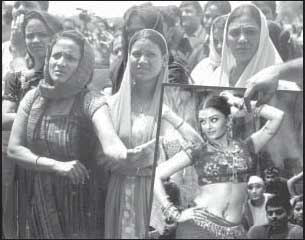
|
Liquor and Entertainment
The bar dancer is a part of the city’s thriving nightlife. Bombay never sleeps. The city is hailed as the crowning glory of the nation’s entertainment industry. From the time when the East India Company developed Mumbai as a port and built a fort in the seventeenth century, Bombay has been a city of migrants. Migrants come to the city in search of livelihoods and with the workers have come the entertainers.
The traders, the sailors, the dockworkers, the construction labourers and the mill hands - all needed to be ‘entertained’. So the government marked areas for entertainment called ‘play houses’ which are referred to in the local parlance even today as ‘pilay house’ areas.Folk theatre, dance and music performances and, later, silent movie theatres all grew around the ‘play houses’ and so did the sex trade. Hence Kamathipura - a name which denoted the dwelling place of a community of construction labourers, the Kamtis of Andhra Pradesh, later came to signal the sex trade or ‘red light’ district of the old Bombay city. Within the red light district there were also places for performance of traditional and classical dance and music, and the mujra houses.
The city of migrants — predominantly male migrants — also needed cheap eating-places. To cater to their needs initially there were Irani restaurants, Chilia (Muslim) restaurants and later South Indian (Udupi) joints and Punjabi dhabas.
The prevalence of dance bars is linked not only to the restaurant industry and the entertainment business, but also to the state policy on the sale of liquor After Independence, during the fifties, when Morarji Desai was Chief Minister, the State of Bombay was under prohibition and restaurants could not serve liquor. But after Maharashtra severed its links with the Gujarat side of the erstwhile Bombay Presidency, the newly formed state reviewed its liquor policy and the prohibition era was transformed into the ‘permit’ era. A place where beer was served was called a ‘permit room’. Only a person who had obtained a ‘permit’ could sit in a permit room and drink beer.
But gradually, the term ‘permit room’ lost its meaning and
the government went all out to promote liquor sale in hotels and restaurants.
It was during this period, sometime in the seventies, that permit rooms
and beer bars started introducing innovative devices to beat their competitors
— live orchestra, mimicry and ‘ladies service bars’
where women from the red light district were employed as waitresses.
| The licenses to hold performances were issued under Rules for Licensing and Controlling Places of Public Amusement (other than Cinemas) and Performances for Public Amusement including Melas and Thamashas, 1960. But soon the low quality orchestra and gazal singing lost its sheen. Some bars then introduced live dance performances to recorded music or live orchestras. Around this time, Hindi films also started introducingsexy ‘item numbers’ and the dancers in thebars imitated these item numbersm during their performances. The Government also issued licenses for performance of ‘cabaretshows’. A place that was notorious for its lewd and obscenecabaret performances is Blue Nile’ which was constantlyraided and was entangledin lengthy litigation. It was this litigation that forced the High Court to examinethe notion of obscenity under S.294 of the Indian Penal Code (IPC) an issue I willdeal with more laborately later in this essay. |
How will the state effect
|
Soon the sale of liquor and consequently the profit margins of the owners recorded an upward trend. This encouraged the owners of other Irani ‘permit room’ restaurants, South Indian eateries and Punjabi dhabas to convert their places into dance bars. Coincidentally, during the same period, the mujra culture in Mumbai was facing loss of patronage and was on the decline. As the waitresses in the ‘ladies service bars’ during this early period were from Kamathipura, which also housed the mujras, this new demand for bar dancers reached these traditional dancers and many sought jobs in dance bars. Even for daughters of sex workers, this was a step forward — from brothel prostitution to dance bars. Soon the phenomenon of ‘dance bars’ spread from South Bombay to Central Bombay, to the Western and Central suburbs, to the satellite cities of New Bombay and Panvel, and from there, along the arterial roads, to other smaller cities and towns of Maharashtra. From a mere 24 dance bars in 1985-86, the number increased tenfolds within a decade to around 210. The next decade 1995-2005 witnessed yet another phenomenal increase. As per a rough estimate, presently there are around 1300 dance bars in Maharashtra.
As the demand grew, women from traditional dancing / performance communities of different parts ofIndia, who were facing a decline in patronage of their age-old profession, flocked to Mumbai (and later to the smaller cities) to work in dance bars. These women from traditional communities have been victims of the conflicting forces of modernization. Women are the primary breadwinners in these communities. But after the Zamindari system introduced by the British was abolished, they lost their zamindar patrons and were reduced to penury. Even the few developmental schemes and welfare policies of the government bypassed many of these communities. From their villages, many moved to cities, towns and along national highways in search of a livelihood. The dance bars provided women from these communities an opportunity to adapt their strategies to suit the demands of the new economy.
Apart from these traditional dancing communities, women from other poor communities also began to seek work in these bars as dancers. These women are mainly daughters of mill workers. With the sole earner having lost his job after the closure of the textile mills, young girls with more supple bodies and the sex appeal of their youth entered the job market to support their families. Similarly endowed women who had worked as domestic maids, or in other exploitative conditions as piece-rate workers, or as door to door sales girls, as well as women workers who had been retrenched from factories and industrial units, also found work in dance bars.
State Revenues and RaidsIn short, the dance bars opened up a new avenue of employment to women from the marginalized sections. It is the paucity of jobs in other sectors, and the boost given by the Maharashtra government to the active promotion of liquor sales that led to the proliferation of dance bars. The maximum proliferation occurred during the Shiv Sena-BJP rule in the nineties. While the business of dance bars flourished in the State, the State administration did not frame any rules to regulate the performances until 2001. The bar owners functioned under regular licenses issued to restaurants and bars. They paid Rs.55,000 per month for the various permits and licenses to the Muncipal Corporation. They also paid an annual excise fee of Rs.80,000. In addition the bar owners also pay Rs.30, 000 per month to the Collector by way of “entertainment fee”. But themaximum gain to the State Government was the 20 percent saletax on liquor.tax on liquor. As the liquor sales increased, so did the profits of the bar owners and the revenue for the state. |
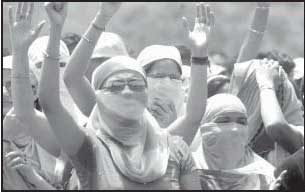
|
The official charge for police protection was a mere Rs. 25 per night and the stipulated period for closing the bars was 12.30 am. But in this Hafta Raj most bars remained open till the wee hours of morning. Only when the haftas (bribes) did not reach the officials in time the bars would be raided. The grounds for raiding the bars were: (a) the owner had violated the license terms by keeping the place open beyond 12.30 am; (b) the dance bar cause “annoyance” through obscene and vulgar display under S.294 of the IPC; and (c) they caused a public nuisance under the Bombay Police Act. After a raid licenses were sometimes either suspended or revoked. But the bar owners say that the government always came to their rescue. They could approach the Home Department for cancellation of the suspension orders issued by the police or for getting the revoked licenses re-issued. All this for a fee! But something went wrong in late 1998. Suddenly, when GopinathMunde of the BJP was the Deputy Chief Minister (DCM), 19 bars were raided in a single night. The State Government also declared a hike of 300 percent in the annual excise fee, lifting it from Rs. 80, 000 to 2,40,000. It was at this point that the bar owners decided to organize themselves. Around 400 bar owners responded to a call given by one Manjeet Singh Sethi; later they formed an association called, ‘Fight for the Rights of Bar Owners Association’ which organised an impressive rally on February 19, 1999. | Women
from traditional dancing / performance communities... who were facing a decline in patronage of their ageold profession, flocked to Mumbai to work in dance bars. Even for daughters of sex workers, this was a step forward — from brothel prostitution to dance bars. |
In order to work out a compromise, the Association approached
the then Commissioner of Police ruling Congress Party, assured him of
their cooperation, and sought his intervention to end the Hafta Raj. They
claim that they had evolved an internal monitoring mechanism to ensure
that all bars abide by the stipulated time for closing down. But the local
police stations were most unhappy at their potential loss of bribes. They
tried to break the unity among the members of the Association. For example,
when the Bar Owners Association tried to take action against those of
their members who violated the agreed upon rules, the police came to their
rescue. The police benefited when bar owners violated the rules and consequently
pay regular haftas. Over a period the regular haftas paid by each bar
owner to the police increased and just before the recent ban, each bar
owner was allegedly paying Rs.75,000 per month by way of bribes to the
Deputy Police Commissioner (DCP) of their zone. Some of this money then
trickles down the police ladder from the DCP to the lowest ranking constable
in predetermined proportions.
Under Congress RuleThe BJP-Sena alliance lost the 1999 Assembly elections and there was a change of regime. TheAssociation started fresh negotiations with the ruling Congress- NCP. They greased the palms of high ranking politicians to allow them to officially stay open more hours, from 12.30 am to 3.30 a.m. so that there would be no need to pay regular haftas for this particular violation. After much negotiation, on January 3, 2001, the first ever regulation regarding dance bars came through a government notification. The bars were granted permission to keep their places open till 1.30 a.m. But somewhere the negotiationsbackfired, or perhaps the right palms were not sufficiently greased. The government decided to increase the police protection charges from Rs.25 to Rs.1500 per day per dance floor. The angry bar owners held rallies and approached the courts. Due to court intervention, the hiked fees were brought down to Rs.500 per night. |
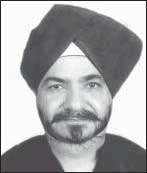
|
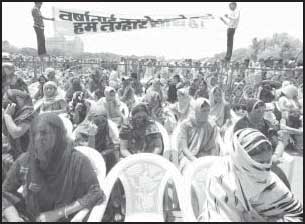
|
Bar owners claim that the police raids increased after a Nationalist Congress Party (NCP) security guard outside a bar beat up a worker in the late hours in the month of February, 2004. Following this, 52 bars were raided in February, and 62 in March 2004. The bar owners alleged that the raids are politically motivated and were connected to the forthcoming State Assembly elections. The ruling Congress Party denied these charges and accused the bar owners of indulging in trafficking of minors. The bar owners approached the High Courts, and several FIRs filed by the police were quashed. Again on July 30, bars were raided. This time, the bar owners filed a Writ Petition in the Bombay High Court and sought protection against constant police harassment. They also organized ahuge rally at Azad Maidan on August 20, 2004. An important feature of this rally was the emergence of the Bar Girls’ Union on the political scenario. Bar Girls Claim AttentionThe mushrooming of an entire industry called the ‘dance bars’ had escaped the |
| notice of the women’s
movement in the city despite the fact that several groups and NGOs
had been working on issues such as domestic violence, dowry harassment,
rape and sexual harassment. Everyone in Mumbai is aware that there
are some exclusive ‘ladies bars’, but usually women, especially
those unaccompanied by men, are stopped at the entrance. Occasionally,
when a bar dancer was raped and/or murdered, women’s groups
had participated in protest rallies organized by local community based
groups, more as an issue of violence against women than as a specific
engagement with the day to day problems of bar dancers.
The August 20 rally in which thousands of bar dancers had participated received wide media publicity. The newspapers reported that there are about 75,000 bar girls. On the day of the rally, a television channel had invited me to give my reaction to the protest by bar dancers. I had welcomed it as a positive step. That was my first interaction with the issue of bar dancers. Soon thereafter, Ms. Varsha Kale, the President of the Bar Girls Union approached me and requested me to represent them through an ‘Intervener Application’ in the Writ Petition filed by the bar owners. Varsha is not a bar dancer, she belonged to a women’s group in Dombvili (in the Central suburbs of Mumbai). Since the issue was new and out of the purview of the regular matrimonial litigation with which our organization, Majlis, isinvolved, we were confused. Varsha explained to us that while for the bar owners it was a question of business losses, for the bar girls it was an issue of human dignity and right tolivelihood. When the bars are raided, it is the girls who are arrested, but the owners are let off. During the raids the police molest them, tear their clothes, and abuse them in filthy language. At times, the girls are retained in the police station for the whole night and subjected to further indignities. But in the litigation, their |
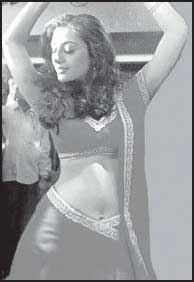
|
As far as the abuse of power by the police was concerned, we were clear. But what about the vulgar and obscene display of the female body for the pleasure of drunken male customers, which was promoted bythe bar owners with the sole intention of jacking up their profits? It is here that we lacked clarity. I had been part of the women’s movement that has protested against fashion parades and beauty contests and semi-nude depiction of women in Hindi films. But my colleagues, Veena Gowda and Shreemoyee Nandini - both young, dynamic, women’s rights lawyers, belonged to a later generation which had come to terms with fashion parades, female sexuality and erotica.
Differing Feminist Perceptions
Finally after much discussion, we decided to take on the challenge and represent the Bar Girls’ Union in the litigation. We invited some of the girls who had been molested to meet with us. Around 35 to 40 girls turned up. We talked to them at length. I also decided to visit some bars. Though I was uncomfortable in an environment of palpable sexual under-currents, I felt that the difference between a bar and a brothel is significant. An NGO, Prerana, which works on anti-trafficking issues, had filed an intervenor application, alleging the contrary – that bars are in fact brothels and that they are dens of prostitution where minors are trafficked. While the police had raided the bars on the ground of obscenity, the Prerana intervention added a new twist to the litigation because they submitted that regular police raids are essential for controlling trafficking and for rescuing minors. The fact that the police had not abided by the strict guidelines in anti-trafficking laws and had molested the women did not seem to matter to them.
Opposing a fellow organisation with which I had a long association was extremely uncomfortable. Prerana had been working with sex workers and had started an innovative project of night crèches for children of sex workers in Kamathipura way back in 1986-87.
I had been involved with several para-legal workshops organized by Prerana for sex workers. During these workshops the main concerns for the sex workers were police harassment and arbitrary arrests. I viewed my intervention on behalf of bar girls as an extension of the work I had done with Prerana, but Prerana members felt otherwise. At times, after the court proceedings, we ended up being extremely confrontational and emotionally charged, with Prerana representatives accusing us of legitimizing trafficking by bar owners and us retaliating by accusing them of acting at the behest of the police.
Under Garb of Morality
From September 2004 to March 2005, the case went through the usual delays. In March, when the case came up for arguments, the lawyer for the bar owners produced an affidavit by the complainant, upon whose complaint the police had conducted the raids. The same person had filed the complaint against nine bars in one night The police officials themselves admitted that he was a ‘professional’ pancha (police witness). The second person who had filed the complaint was a petty criminal. In the affidavit produced by the bar owners, the professional pancha stated that he was not present at any of the bars against whom he had filed the complaints and the complaints were filed at the behest of the police.
This rocked the boat for the police and invited the wrath of the judges
against them. They were asked to file an affidavit explaining this new
development. This turned out to be the last day of the court hearing.
Before the next date, the DCM R. R. Patil had already announced the ban.
So in view of this, according to the police prosecutor, the case had become
infructuous.
| Rather ironically, just around the time when the DCM’s announcementregarding the dance bar ban was making headlines, the Nagpur Bench of the Bombay High Court gave a ruling on the issue of obscenity in dance bars. While according to the Home Minister the dances in bars are obscene and have a morally corrupting influence on society, the High Court held that dances in bars do not come within the ambit of S.294 of the IPC. The police had conducted raids on a dance bar in Nagpur and initiated
criminal proceedings against the owners as well as the dancers on
grounds of obscenity and immorality. The bar owners had approached
the High Court for quashing the proceedings on the ground that the
raids were conducted with a malafide intention by two IPS officers
who hada grudge against them. In his affidavit filed before the
High Court, the Joint Commissioner of Police, Nagpur stated as follows:
“It is found that certain girls were dancing on the floor
and were making indecent gestures. The girls were mingling with
the customers, touching their bodies, and the customers were paying
money to them.” |
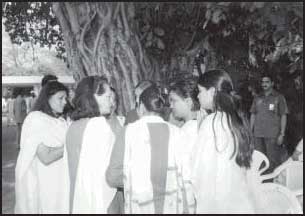
|
| When
the bars are raided, it is the girls who are arrested, but the owners are let off. During the raids the police molest them, tear their clothes, and abuse them in filthy language. |
On April 4, 2005, Justice A. H. Joshi presiding over the Nagpur Bench of the Bombay High Court quashed the criminal proceedings initiated by the Police on the ground that the case made out by the police does not attract the ingredients of Section 294 of the IPC. Section 294 is attracted only when annoyance is caused to another, due to obscene acts in a public place. The Court held that the affidavit filed by the Joint Commissioner of Police did notreveal that annoyance was caused to him personally or to any other viewer due to the alleged obscene dancing. This ruling followed several earlier decisions by the Bombay High Court, which had addressed the issue of obscenity in dance bars. One of the earliest rulings on this issue is by Justice Vaidhya in the State of Maharashtra vJoyce Zee aliasTemiko in 1978 where the court examined whether cabaret shows constitute obscenity. |
|
While dismissing the appeal filed by the State, the Bombay High
Court held as follows: “An adult person, who pays and attends
a cabaret show in a hotel runs the risk of being annoyed by the
obscenity…” Interestingly, prior to the raid, the policemen
had sat through the
|
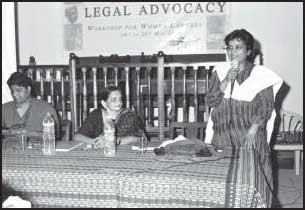
|
The DCM’s statement announcing the ban was followed by unprecedented media glare, and we found ourselves in the centre of the controversy as lawyers representing the Bar Girls’ Union.The controversy had all the right ingredients.
The controversy had all the right ingredients - titillating sexuality, a hint of the underworld, a faintly visible crack in the ruling Congress-NCP alliance, and polarized positions among social activists.Sonia Gandhi, the Congress President and sought her intervention. Other women’s groups joined in and issued a statement opposing the ban.
Opposition to Dance Bars
An equal or even greater number of NGOs and social activists issued statements
supporting the ban. The child-right’s and anti-trafficking groups
led by Prerana issued a congratulatory message to the DCM and claimed
that they had won. Then women members of the NCP came on the street brandishing
the banner of depraved morality. The Socialists and Gandhians joined them
with endorsements from stalwarts like Mrinal Gore and Ahilya Rangnekar
to aid them. These statements had the blessings of a retired High Court
judge— Justice Dharmadhikari. Paid advertisements appeared in newspapers
and signature campaigns were held at railway stations. ‘Sweety and
Savithri — who will you choose?’ goaded the leaflets distributed
door to door, along with the morning newspaper. The term ‘Savithri’,
denoted the traditional pativrata, an ideal for Indian womanhood, while
‘Sweety’ denoted the woman of easy virtue, the wrecker of
middle class homes.
| The
Gandhians seem to be only against the dancers and not against the bars that have proliferated. Nor have they done much to oppose the liquor policy of the State, which had encouraged bar dancing. |
Interestingly, the Gandhians seem to be only against the dancers and not against the bars that have proliferated. Nor have they done much to oppose the liquor policy of the State, which had encouraged bar dancing. The antitrafficking groups who had been working in the red light districts had not succeeded in making a dent in child trafficking in brothels that continue to thrive. But in this controversy, brothel prostitution and trafficking of minors has been relegated to the sidelines. The sex worker is viewed with more compassion than the bar dancer, who may or may not resort to sex work.
|
While the ban will affect the bar dancer from the ordinary dhabas run by Punjabis and Sardars and the South Indian eateries run by the Shetty community, it will not affect the higher classes of dancers who perform in hotels which hold three or more “stars”, or clubs and gymkhanas. Can the State impose arbitrary and varying standards of vulgarity, indecency and obscenity for different sections of society or classes of people? If an ‘item number’ of a Hindi film can be screened in public theatres, then an imitation of the same cannot be termed as ‘vulgar’. The bar dancers imitate what they see in Indian films, television serials, fashion shows and advertisements. All these industries have used women’s bodies for commercial gain. There is sexual exploitation of women in these and many other industries. But no one has ever suggested that you close down these industries because there is sexual exploitation of women!
The ban will not affect the bars. The profit margins may go down for a while, but soon other devices will be found to promote liquor sale. Bars employ women as waitresses and the proposed ban will not affect this category. Waitresses mingle with the customers more than the dancers who are confined to the dance floor. If the anti-trafficking laws have not been successful in preventing trafficking, how will ban on bar dancing prevent trafficking? And if certain bars were functioning as brothels, why were the licenses issued to them not revoked?
Physician Heal Thyself
While the hue and cry about the morality of dance bars was raging, in
Sangli district, the home constituency of the Deputy Chief Minister (DCM),
a dance performance titled ‘Temptation’ by Isha Kopikar, the
hot selling ‘item girl’ of Bollywood, was being organized
to raise money for the Police Welfare Fund. The bar girls flocked to Sangli
to hold a protest march. This received even more publicity than the performance
by Isha Kopikar who, due to the adverse publicity, was compelled to dress
modestly and could not perform in her usual flamboyant style. The disappointed
public felt it was more value for their money to see the protest of the
bar girls than to witness a lack luster performance by the ‘item
girl’. And the bar girls raised a pertinent question, whether different
rules of morality apply to the police and the Home Minister.
| Is
it her earning capacity, the legitimacy awarded to her profession, and the higher status she enjoys in comparison to a sex worker that invite the fury from the middle class Maharashtrian moralists? |
Another controversy surfaced when the late Sunil Dutt, the popular and highly respected Congress MP from Mumbai, as well as Govinda, the newer entrant to politics and also a Congress MP from North-West Mumbai, issued statements opposing the ban. Govinda himself hails from a performer community. And Sunil Dutt had responded as a performer. Justice H. Suresh, a retired Bombay High Court judge and wellknown defender of human rights also opposed the ban. All this has been heady news for the television channels and the tabloids. ‘Dance Bars to Sex Bars’ blared a recent tabloid headline, which splashed photographs allegedly taken from a hidden camera. The report stated that desperate dancers without work are now resorting to oral sex in sleazy bars in the outskirts of Mumbai to earn money. Another report stated that the mujra places, which had earlier closed down, have received a boost. The worst was the news story of a young journalist who visited theof a young journalist who visited the DCM, claiming to be a bar dancer, photographer in toe, with the intention of trapping him in a compromising position. But the plot boomeranged and the journalist and the photographer were arrested. |
Later the DCM issued a statement that the girl was a mere pawn used by the editor and the same thing happens to the bar dancers. One wonders whether he will now ban women from working as journalists in newspapers because there is likelihood of exploitation! So, all in all, during the last few months, the city is abuzz with never a dull moment.
A Peep into Reality
Since most activists on both sides of the divide had never visited a bar, to dispel some of the prevailing myths, some women’s groups were keen to conduct a study. TheWomen’s Studies Centre of the S.N.D.T. University, Mumbai, also got involved. Through the intervention of the Bar Girls’ Union, the bar owners were contacted and the dance bar doors were opened to the research team. Time was running out as the cabinet had cleared the Ordinance and had sent it to the Governor for approval.
The research team acted quickly and interviewed 153 dancers from 15 randomly selected bars across the city. The bars had been selected keeping in view the cultural and socio-economic diversity of the city. The women were interviewed within the bars, during their rest intervals. This methodology also provided an opportunity to observe the working conditions and extent of sexual exploitation within the bars.
The Governor did not sign the Ordinance on the expected date and the time factor swung in favour of the anti-ban lobby. On June 13, 2005, the Research Unit of S.N.D.T. and women’s groups held a press conference and released a preliminary report. The study helped to bring into question many of the popular myths regarding bar dancers.
Contrary to the official statement that more than 75 percent of the dancers are Bangladeshis and constitute a security risk, the sample study revealed that only 2 of the 153 girls who were interviewed were outsiders – they were Nepalis. Around 20 percent of the women were either from Mumbai or came from poverty stricken districts of Maharashtra. 50 percent of the women who were interviewed were from backward castes, marginalized communities and notified tribes of Madhya Pradesh, Uttar Pradesh and Rajasthan - Bedia, Chari, Rajnat, Dhanawat, etc. The literacy levels were low – 50 percent were illiterate and only 25 percent had studiedbeyond the primary level. They had no training in any other skills.
In 60 percent of the cases women were the sole breadwinners of their
families. Their average monthly income ranged from Rs.5000 to Rs.35,000.
None of them owned property or even a dwelling house. They lived in rented
tenements. Out of their earnings, they spent a sizeable amount on costumes,
makeup, travel and rent. The rest was spent on children’s education,
for the marriage expenses of their sisters, and for medical expenses of
ailing parents. Most sent some money back to their families in their villages.
| Contrary
to the official statement that more than 75 percent of the dancers are Bangladeshis and constitute a security risk, the sample study revealed that only 2 of the 153 girls who were interviewed were outsiders – they were Nepalis |
All the mothers chased a dream - to send their children to English medium schools. Though the sample size is small, the random survey served to refute the premise that bars are in fact brothels where minors are trafficked. The average age of the women who were interviewed was 21 - 25. But 55 percent of the women had entered the bars when they were minors, between the ages of 15-18. This is not surprising as most girls from disadvantaged socio-economic groups either enter the job market or are married off by this age.The dancers came to the bars through contacts with other women from their community or friends who were working in bars. They were in the profession out of choice, though some admitted that they did not enjoy dancing. |
50
percent of the women who were interviewed were from backward castes, marginalized communities and notified tribes of Madhya Pradesh... 50 percent were illiterate and only 25 percent had studied beyond the primary level... in 60 percent of the cases women were the sole breadwinners of their families. |
The dancers stated that they had a greater security in the bars due to the support network among the dancers as well as the protection provided by the owners. Usually each bar had 30-60 dancers. The drivers of taxis and auto rickshaws that were used to take them to work and back were regulars and hence they did not feel insecure while travelling home late at night. The only thing they feared was the police raid and the sexual exploitation by the guardians of the law! The positive outcome of the entire controversy and the media glare has brought the bar girl out of her closeted existence. It has made the bars more transparent and accessible for women activists and researchers. But several lurking doubts continue to haunt me. Due to the impending ban the lot of the bar owners and the bar girls has been thrown together by the political developments and there is no other choice for both but to struggle for their survival together.
Today the interests of bar girls and the bar owners are common. But what will happen tomorrow if the Bar Girls’ Union takes up questions which are uncomfortable for the bar owners? Can the Union operate without the support and approval of bar owners? Does it have the strength to negotiate better working conditions for the bar dancer?
| And what about the women’s groups who are opposing the ban? Has our intervention strengthened the bar owners and wrapped them with a cloak of legitimacy? Initially women’s groups resisted, but it had become obvious that if the women’s groups wanted to play any role at all, they would have to deal with the bar owners. This realization dawned on the anti-ban groups very late. Only within an atmosphere of mutual trust was it possible to enter the bars and conduct the study. Personally, the entire experience has helped me to gain greater insights into the lives of women who live at the margins and form the underbelly of the city’s nightlife. It has also helped me to question my own notions of morality and to encounter the sleazy world of sexual erotica. I have become astutely aware of the realities of a bar dancer and the various levels of power politics that is played out upon her body. But what have been the gains for the bar dancer? Were the underground existence and the invisibility within which she negotiated her sexuality, morality, and economics more comfortable to her? Has the exposure made her even more vulnerable than the condition she was living in, before all of us entered her life? I do not know. The ban has become effective since August 15, 2005. However, neither the bar owners nor the bardancers are ready to give up their battle for survival. Two different associations of bar owners have filed two writ petitions— Manjit Singh Sethi’s organisation — Fight for the Rights of Bar Owners has filed a criminal writ petition. It is scheduled for interim hearing on August 29, 2005. Indian Hotels and Restaurants Association (AHAR) has filed a civil writ petition which is listed for final hearing on October 3, 2005. The Bharatiya Bar Girls Union (Varsha Kale - represented by VeenaGowda of Majlis and myself) have filed a civil writ petition which has been tagged along with AHAR petition and will be heard on October 3, 2005. Acknowledgement: I thank Varsha Kale, President of the Bharatiya Bar Girls Union and the bar dancers for the insights into this issue. However, the views expressed here are mine alone. About the author: Flavia Agnes is a lawyer and women’s rights activist. She is also the founder member of Majlis, a legal and cultural resource centre based in Mumbai. |
|
|
Copyright © 2006, Manushi Trust, All Rights Reserved.


